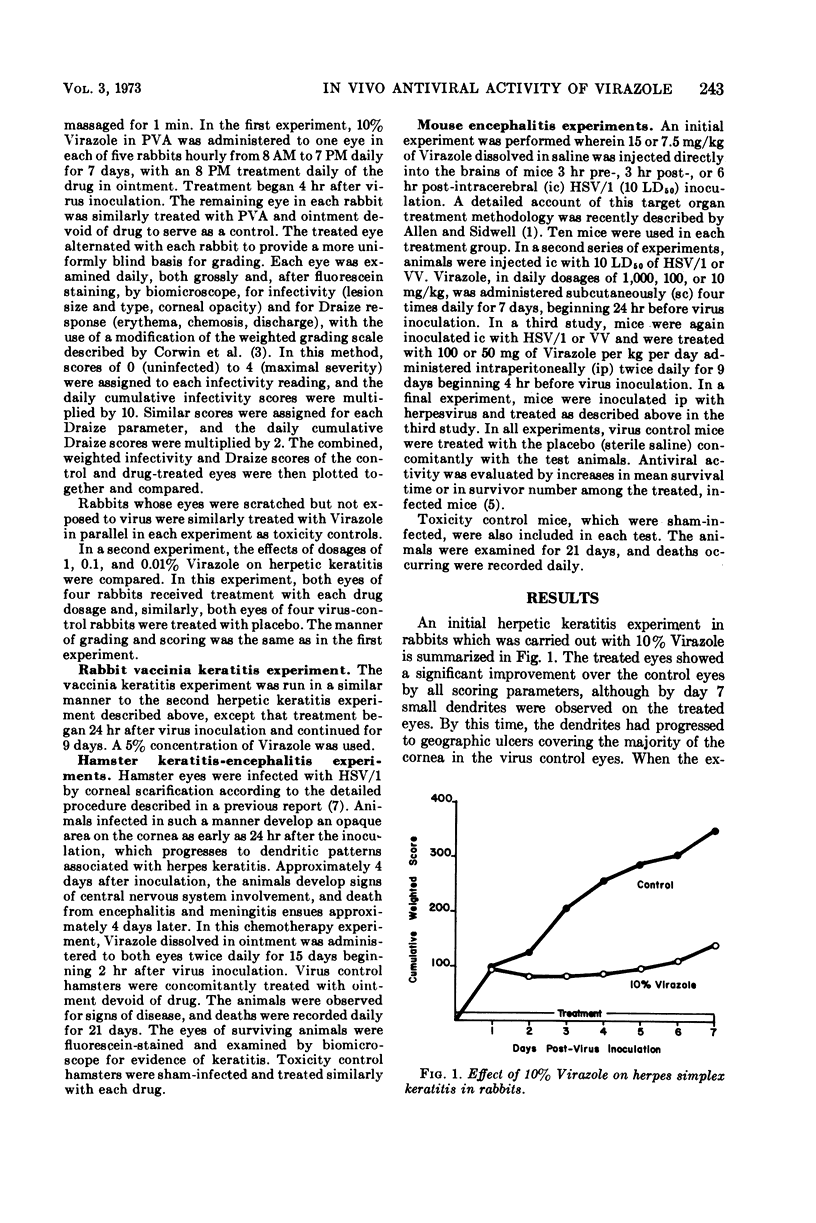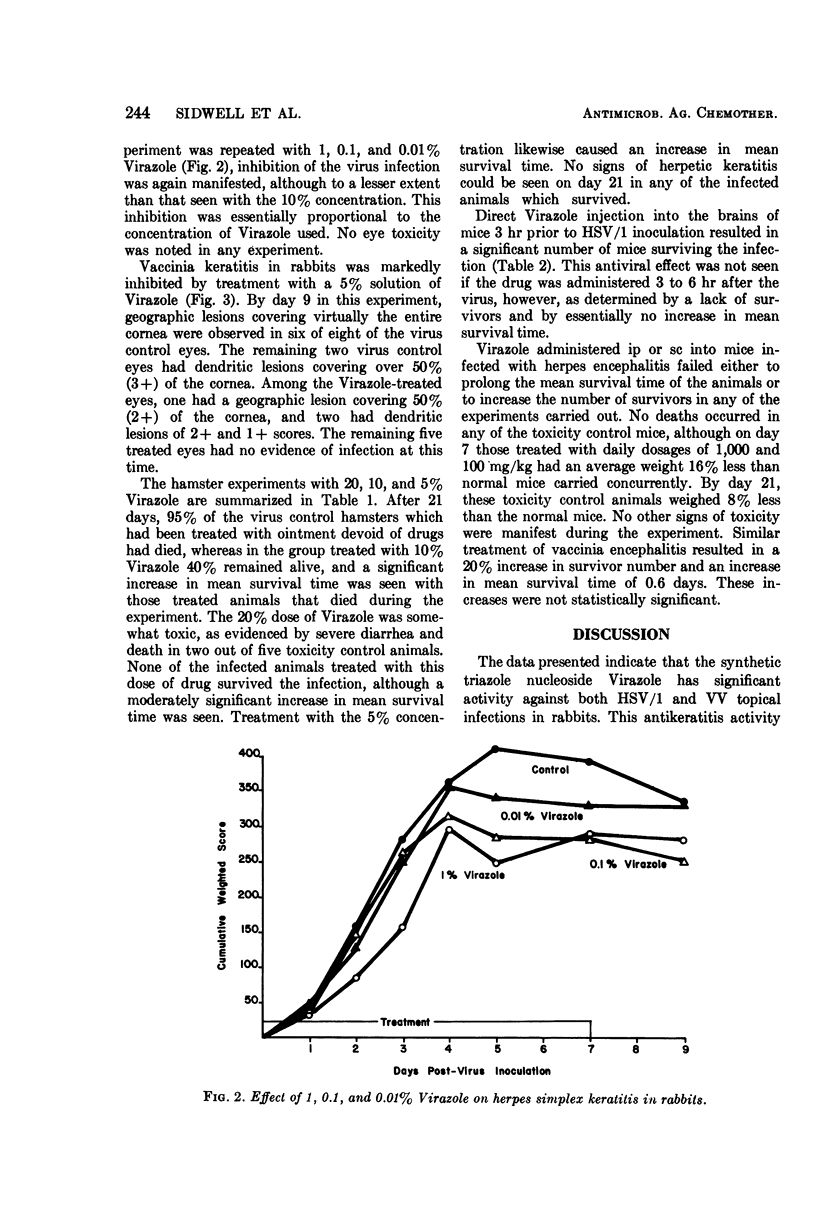Abstract
Topical application of 1-β-d-ribofuranosyl-1,2,4-triazole-3-carboxamide (Virazole) significantly inhibited the development of herpetic keratitis in the eyes of rabbits, as determined by both infectivity and Draize scoring parameters. Significant inhibition of the infection was demonstrated with 10% concentrations of Virazole; a 1% solution had a moderate effect, whereas doses of 0.1 and 0.01% had little activity in this system. A 5% concentration of Virazole similarly inhibited vaccinia keratitis in rabbits. Encephalitis-induced mortality in hamsters initially infected intraocularly with herpesvirus was significantly prevented or inhibited by topical application of 5, 10, and 20% concentrations of Virazole. Surviving, treated hamsters had no signs of herpes keratitis. The 20% concentration was the approximate LD50 in hamsters. Virazole administered subcutaneously or intraperitoneally to mice did not appreciably alter the course of herpes virus- or vaccinia virus-induced encephalitis in these animals, although in a herpesvirus experiment direct injection of the drug into the brains 3 hr prior to virus inoculation resulted in a significant survivor increase.
Full text
PDF




Selected References
These references are in PubMed. This may not be the complete list of references from this article.
- Allen L. B., Sidwell R. W. Target-organ treatment of neurotropic virus diseases: efficacy as a chemotherapy tool and comparison of activity of adenine arabinoside, cytosine arabinoside, idoxuridine, and trifluorothymidine. Antimicrob Agents Chemother. 1972 Sep;2(3):229–233. doi: 10.1128/aac.2.3.229. [DOI] [PMC free article] [PubMed] [Google Scholar]
- CORWIN M. E., COLEMAN V., RIEGELMAN S., OKUMOTO M., JAWETZ E., THYGESON P. EFFECT OF IUDR AND AMETHOPTERIN ON EXPERIMENTAL HERPES SIMPLEX KERATITIS. Invest Ophthalmol. 1963 Dec;2:578–583. [PubMed] [Google Scholar]
- Huffman J. H., Sidwell R. W., Khare G. P., Witkowski J. T., Allen L. B., Robins R. K. In vitro effect of 1-beta-D-ribofuranosyl-1,2,4-triazole-3-carboxamide (virazole, ICN 1229) on deoxyribonucleic acid and ribonucleic acid viruses. Antimicrob Agents Chemother. 1973 Feb;3(2):235–241. doi: 10.1128/aac.3.2.235. [DOI] [PMC free article] [PubMed] [Google Scholar]
- Sidwell R. W., Dixon G. J., Sellers S. M., Schabel F. M., Jr In vivo antiviral properties of biologically active compounds. II. Studies with influenza and vaccinia viruses. Appl Microbiol. 1968 Feb;16(2):370–392. doi: 10.1128/am.16.2.370-392.1968. [DOI] [PMC free article] [PubMed] [Google Scholar]
- Sidwell R. W., Huffman J. H., Khare G. P., Allen L. B., Witkowski J. T., Robins R. K. Broad-spectrum antiviral activity of Virazole: 1-beta-D-ribofuranosyl-1,2,4-triazole-3-carboxamide. Science. 1972 Aug 25;177(4050):705–706. doi: 10.1126/science.177.4050.705. [DOI] [PubMed] [Google Scholar]
- Sidwell R. W., Sellers S. M., Dixon G. J. Herpes simplex keratitis in hamsters as a system for evaluating potential antiviral agents. Antimicrob Agents Chemother (Bethesda) 1966;6:483–488. [PubMed] [Google Scholar]
- Witkowski J. T., Robins R. K., Sidwell R. W., Simon L. N. Design, synthesis, and broad spectrum antiviral activity of 1- -D-ribofuranosyl-1,2,4-triazole-3-carboxamide and related nucleosides. J Med Chem. 1972 Nov;15(11):1150–1154. doi: 10.1021/jm00281a014. [DOI] [PubMed] [Google Scholar]


